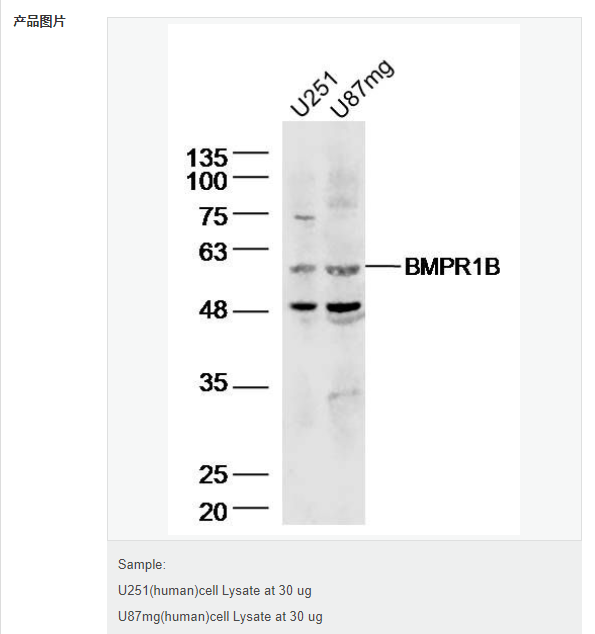

貨號(hào)
產(chǎn)品規(guī)格
售價(jià)
備注
BN41945R-50ul
50ul
¥1486.00
交叉反應(yīng):nan(predicted:Human,Mouse,Rat,Dog,Cow,Rabbit,Sheep) 推薦應(yīng)用:WB,ELISA
BN41945R-100ul
100ul
¥2360.00
交叉反應(yīng):nan(predicted:Human,Mouse,Rat,Dog,Cow,Rabbit,Sheep) 推薦應(yīng)用:WB,ELISA
BN41945R-200ul
200ul
¥3490.00
交叉反應(yīng):nan(predicted:Human,Mouse,Rat,Dog,Cow,Rabbit,Sheep) 推薦應(yīng)用:WB,ELISA
產(chǎn)品描述
| 英文名稱 | BMPR1B |
| 中文名稱 | 骨形態(tài)發(fā)生蛋白受體1B抗體 |
| 別 名 | BMPR-IB; Activin receptor like kinase 6; Acvrlk6; ALK 6; ALK6; alk6tr; BMP type-1B receptor; BMPR IB; BMPR-1B; Bmpr1b; BMPRIB; BMR1B_HUMAN; Bone morphogenetic protein receptor type 1B; Bone morphogenetic protein receptor type IB; Bone morphogenetic protein receptor type-1B; BR 1b; BR1b; CDw 293; CDw293; CDw293 antigen; CFK 43a; CFK43a; Serine/threonine receptor kinase; zALK 6; zALK6. |
| 研究領(lǐng)域 | 細(xì)胞生物 信號(hào)轉(zhuǎn)導(dǎo) 干細(xì)胞 轉(zhuǎn)錄調(diào)節(jié)因子 激酶和磷酸酶 細(xì)胞表面分子 細(xì)胞外基質(zhì) 表觀遺傳學(xué) |
| 抗體來源 | Rabbit |
| 克隆類型 | Polyclonal |
| 交叉反應(yīng) | (predicted: Human, Mouse, Rat, Dog, Cow, Rabbit, Sheep, .) |
| 產(chǎn)品應(yīng)用 | WB=1:500-2000 ELISA=1:5000-10000 not yet tested in other applications. optimal dilutions/concentrations should be determined by the end user. |
| 分 子 量 | 56kDa |
| 細(xì)胞定位 | 細(xì)胞膜 |
| 性 狀 | Liquid |
| 濃 度 | 1mg/ml |
| 免 疫 原 | KLH conjugated synthetic peptide derived from human BMPR1B:61-160/502 <Extracellular> |
| 亞 型 | IgG |
| 純化方法 | affinity purified by Protein A |
| 儲(chǔ) 存 液 | 0.01M TBS(pH7.4) with 1% BSA, 0.03% Proclin300 and 50% Glycerol. |
| 保存條件 | Shipped at 4℃. Store at -20 °C for one year. Avoid repeated freeze/thaw cycles. |
| PubMed | PubMed |
| 產(chǎn)品介紹 | On ligand binding, forms a receptor complex consisting of two type II and two type I transmembrane serine/threonine kinases. Type II receptors phosphorylate and activate type I receptors which autophosphorylate, then bind and activate SMAD transcriptional regulators. Receptor for BMP7/OP-1 and GDF5. Involvement in disease; Defects in BMPR1B are the cause of acromesomelic chondrodysplasia with genital anomalies (AMDGA). Acromesomelic chondrodysplasias are rare hereditary skeletal disorders characterized by short stature, very short limbs, and hand/foot malformations. The severity of limb abnormalities increases from proximal to distal with profoundly affected hands and feet showing brachydactyly and/or rudimentary fingers (knob-like fingers). Defects in BMPR1B are a cause of brachydactyly type A2 (BDA2) [MIM:112600]. Brachydactylies (BDs) are a group of inherited malformations characterized by shortening of the digits due to abnormal development of the phalanges and/or the metacarpals. They have been classified on an anatomic and genetic basis into five groups, A to E, including three subgroups (A1 to A3) that usually manifest as autosomal dominant traits. BDA2 was described first in a large Norwegian kindred. BDA2 is caused by mutations in BMPR1B gene and studies demonstrate that these mutations function as dominant negatives in vitro and in vivo. Function: On ligand binding, forms a receptor complex consisting of two type II and two type I transmembrane serine/threonine kinases. Type II receptors phosphorylate and activate type I receptors which autophosphorylate, then bind and activate SMAD transcriptional regulators. Receptor for BMP7/OP-1 and GDF5. Subcellular Location: Membrane; Single-pass type I membrane protein. DISEASE: Defects in BMPR1B are the cause of acromesomelic chondrodysplasia with genital anomalies (AMDGA) [MIM:609441]. Acromesomelic chondrodysplasias are rare hereditary skeletal disorders characterized by short stature, very short limbs, and hand/foot malformations. The severity of limb abnormalities increases from proximal to distal with profoundly affected hands and feet showing brachydactyly and/or rudimentary fingers (knob-like fingers). Defects in BMPR1B are a cause of brachydactyly type A2 (BDA2) [MIM:112600]. Brachydactylies (BDs) are a group of inherited malformations characterized by shortening of the digits due to abnormal development of the phalanges and/or the metacarpals. They have been classified on an anatomic and genetic basis into five groups, A to E, including three subgroups (A1 to A3) that usually manifest as autosomal dominant traits. BDA2 was described first in a large Norwegian kindred. BDA2 is caused by mutations in BMPR1B gene and studies demonstrate that these mutations function as dominant negatives in vitro and in vivo. Similarity: Belongs to the protein kinase superfamily. TKL Ser/Thr protein kinase family. TGFB receptor subfamily. Contains 1 GS domain. Contains 1 protein kinase domain. SWISS: O00238 Gene ID: 658 Database links: Entrez Gene: 658 Human Entrez Gene: 12167 Mouse Omim: 603248 Human SwissProt: O00238 Human SwissProt: P36898 Mouse Unigene: 598475 Human Unigene: 39089 Mouse Important Note: This product as supplied is intended for research use only, not for use in human, therapeutic or diagnostic applications |
